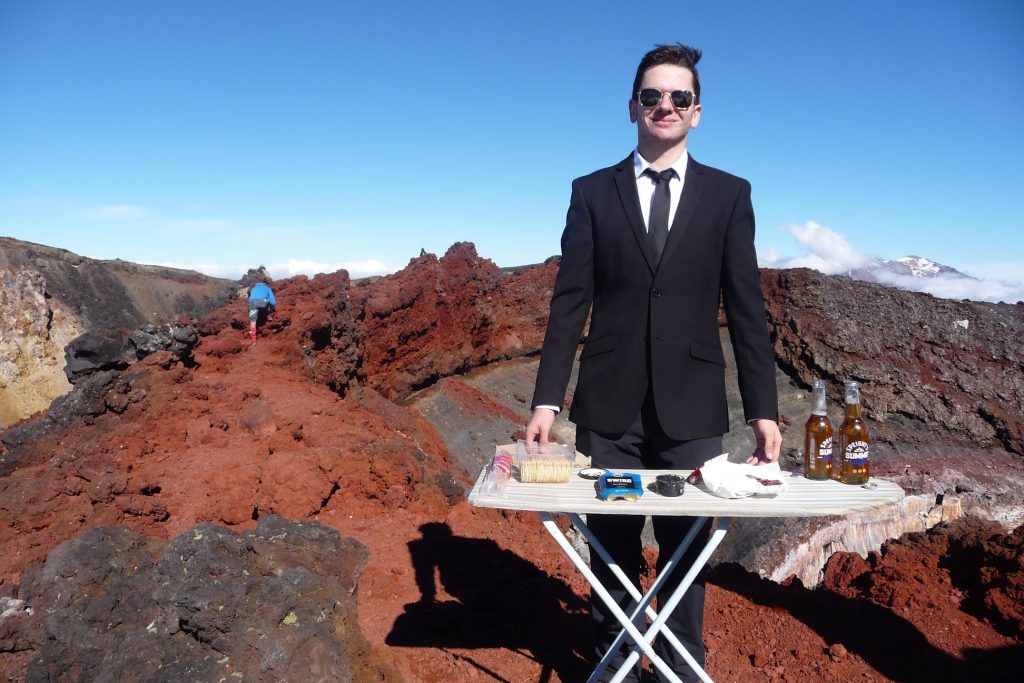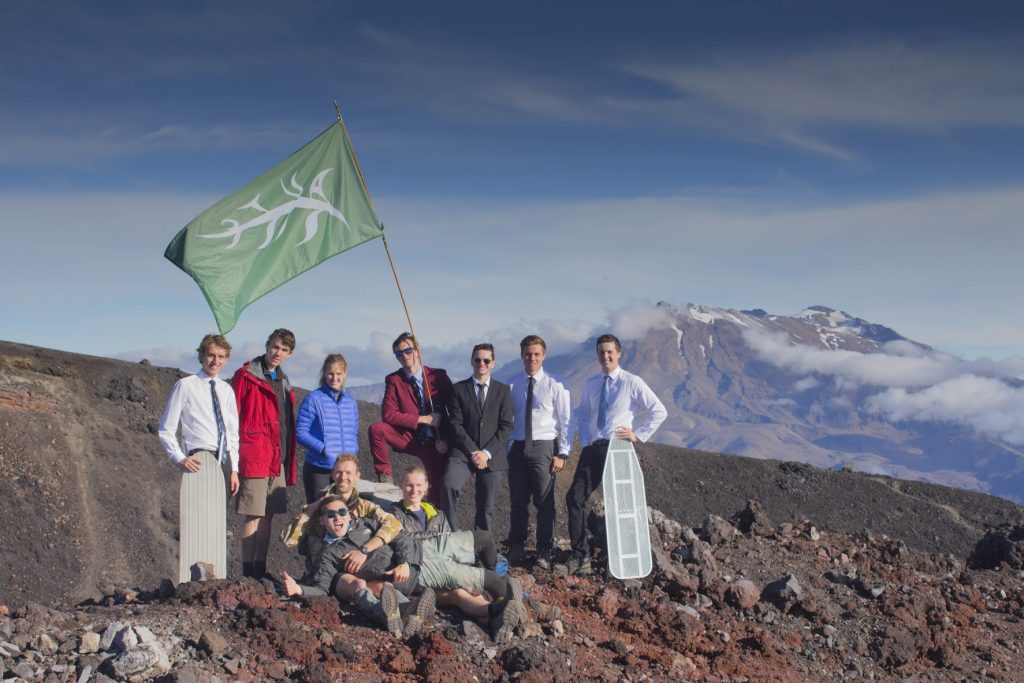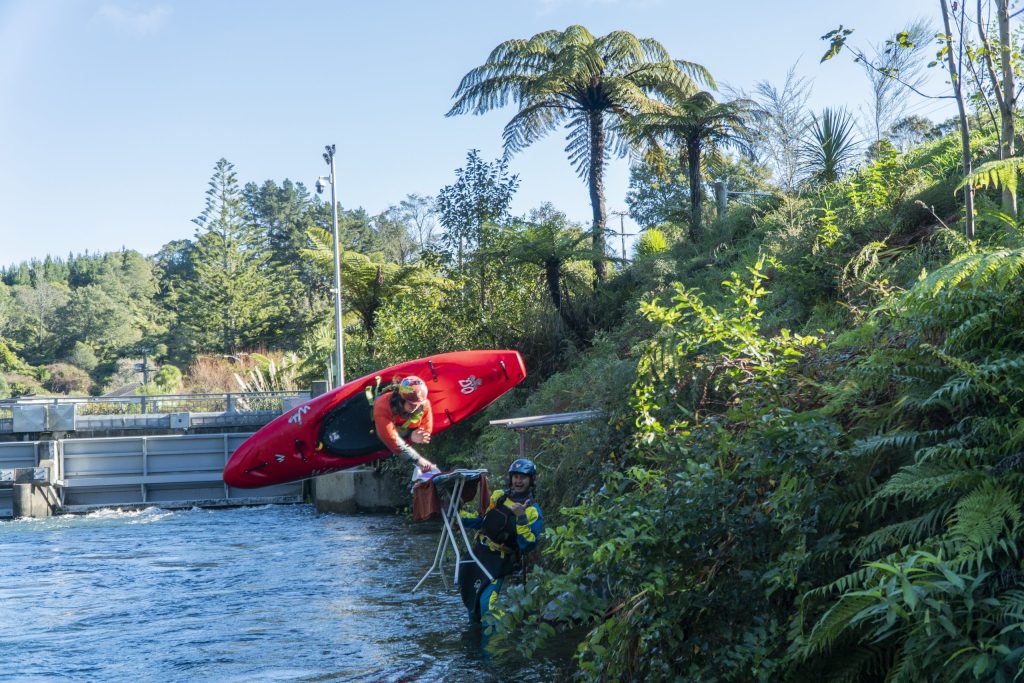“HAVE YOU EVER BEEN BUSH-BASHING WITH AN IRONING BOARD? IT’S AWFUL, IT’S REALLY AWFUL. BUT WE DID IT EVERY WEEKEND,” REMEMBERS SACHA KNIGHT. SACHA IS THE FORMER PRESIDENT OF THE AUCKLAND UNIVERSITY TRAMPING CLUB AND, CRUCIALLY, ONE OF THE FOUNDING MEMBERS OF ITS EXTREME IRONING DIVISION (EID). HIS NICKNAME IS TRAIN TRACKS. MORE ON THAT LATER.

As the name suggests, extreme ironing takes one of the most mundane domestic duties and invigorates it with the addition of adrenaline-packed pursuits like rock- climbing, scuba diving, bungee jumping and paragliding. It can be formal or informal, spontaneous or organised, competitive or casual, but it always combines two things: “the thrill of an extreme outdoor activity with the satisfaction of a well-pressed shirt”. For a small group of New Zealanders, it became a passion.
The general consensus (and the official story spread by the Extreme Ironing Bureau, the sport’s leading body) is that extreme ironing was created in Leicester, England in 1997 by a man named Phil Shaw. But its origins are disputed. Some say the inception of extreme ironing predates Shaw’s claim by nearly twenty years, with credit belonging to another Englishman, Tony Hiam.
In 1980, in the market town of Settle on the edge of the Yorkshire Dales National Park, Tony Hiam began to approach ironing in a new way. Supposedly inspired by the immense care shown by his eccentric brother-in-law, John Slater – who ironed his clothes even when he was going camping – Tony wanted to demonstrate the futility of unnecessary ironing by taking it beyond the confines of the home, to mountain lookouts, telephone kiosks and the top of clothing donation bins. For the next 10 years, Tony drove around with an iron and board in the boot of his car, always ready to set up in some unconventional spot in an effort to get passersby to question their own sanity when they witnessed a man pressing his shirt collars in the middle of a Yorkshire moor.

The other version of events is that told by Phil Shaw himself. According to Phil, he had come home from his job at a local knitwear factory to a pile of ironing. He really wanted to go rock-climbing, but he didn’t want to shirk his household responsibilities. Not wanting to waste the sunny day, Phil compromised and took an ironing board, iron and extension cord out to the back garden. When his flatmate asked him what on earth he was doing, Phil responded “extreme ironing”.
Whether or not Phil really did invent extreme ironing, he is responsible for bringing it into the public eye. Adopting the nickname Steam – ironing and laundry-related nicknames are something of a prerequisite for participation in the sport – he embarked on a promotional world tour in 1999. With stops in the United States, Fiji, South Africa, Australia and Aotearoa, extreme ironing began to spread beyond the English Midlands.
It was a chance meeting during the millennium celebrations in New Zealand that cemented extreme ironing as global, not just English, pursuit. Here, Phil met one of those wonderful and ever-present fixtures of the New Zealand outdoors: a German tourist. According to the Team Steam website, his name was Kai, and Kai liked what he saw. Dubbing himself Hot Crease, he became the founder of the German Extreme Ironing Section (GEIS), and the first official international ironist.

The German and British divisions faced off in several iron-offs, before collaborating on the inaugural Extreme Ironing World Championships, held in Munich in 2002. Competing in five sections – Urban, Water, Forest, Lauda and Freestyle – ironists were judged on the creativity of their ironing as well as their final crease count. Highlights included an inverted Austrian ironing upside down in a tree, and Steam belting out ‘God Save the Queen’ as he ironed atop an inner tube in the river section. Various records were set in the years that followed, including a world altitude record (first set by three British climbers who ironed a Union Jack near Everest Base Camp) and the record for most divers ironing simultaneously underwater (86, or 173 if you accept a Dutch attempt made in an indoor pool).
In the leadup to the World Champs, a television crew shadowed Steam, his girlfriend Short Fuse, and the rest of the British team (Starch, Basket, Tirony, Iron Matron and Fe) as they prepared to go head-to-head with teams from Austria, Australia, Chile, Croatia and Germany. The resulting documentary, Extreme Ironing: Pressing for Glory follows Steam and the crew as they embark on training sessions in the French Alps, atop local water towers, and of course, in their own backyards. As well as the main British team, the crew filmed a splinter cell, Urban Housework, who had broken off to start their own extreme sport, which mainly involved downhill vacuum cleaner riding.
Throughout its nearly hour-long runtime, the film constantly probes one core question: are these people for real? On one hand, it all comes across as one big joke that’s gone too far; on the other, the seriousness with which every character carries themselves is convincing. Either way, they attracted international media coverage and corporate sponsorship from leading laundry and whitegoods manufacturers – even Urban Housework were gifted several vacuums by Electrolux.
Meanwhile, a modest but proud tradition of extreme ironing in New Zealand had started to percolate, and later to grow, thanks to a committed group of individuals in the Auckland University Tramping Club (AUTC). As Sacha explains, it all began in late 2016. “Extreme ironing was something a bunch of us had always known about. Someone suggested it and we thought, ‘this is the right kind of silly’.”
The first official trip took place that summer when several club members set off up Mount Ruapehu with suits stuffed into their packs and two ironing boards fastened to the outside of them. Unfortunately, they forgot the irons. But they got some good photos, and one club member, Tom, discovered that an ironing board makes an excellent snowboard.
(Irons continued to be problematic. As Sacha points out, “it’s definitely niche and I think a large portion of that is that most university students don’t have ironing boards – as dumb as it sounds, I think that’s actually a limiting factor.”)
Extreme ironing was not adopted widely in the AUTC, but for a group of about eight of the club’s 700 members, it became a focal point. “There were a couple of years there where every trip that went out had an ironing board with it, no matter what you were doing,” Sacha remembers. What was it about extreme ironing that inspired such commitment? “I think the appeal is about appreciating two things that shouldn’t go together. Also, you can’t cheat. There’s no making it easy. Ultimately, it’s a big, cumbersome, heavy object, often several heavy objects, and you have to carry them somewhere remote or ridiculous. There’s no way that you can sort of improvise or fake it. There’s genuine hardship.”

It does feel like there’s something about the graft required that makes extreme ironing a natural fit for New Zealand’s particular brand of outdoor culture, and the tradition of giving things a go. Then there’s the fact that we are a nation deeply devoted to taking the piss. According to Matt “Iron Fist” Battley, another founding member of the EID, “There is a lot to be said for the Kiwi combination that we all love the outdoors, and we all love having a bit of a laugh.” For him, it makes perfect sense that extreme ironing would appeal in this part of the world, and that, “like everything else in New Zealand, it arrived about 10 years late.”
For Matt, the sense of community is key as well. “You end up with quite a tight bunch of people who have all enjoyed doing this thing together, and you’ve all worked as part of a team to create what was a somewhat difficult, but also completely pointless day, out on the hills.” His brother, and fellow ironist, Andrew “Synthetic” Battley agrees, noting that extreme ironing fits right into AUTC’s tradition of doing slightly stupid things because, why not? “All the way back to our roots in the 1930s, people have been doing dumb things in the Auckland University Tramping Club. If we had been a less silly club it might have popped up, there might have been a trip or two, but we wouldn’t have had the same body of people who were keen to keep it going,” he explains.
Most of the EID core have now graduated from university, which makes me wonder if the ironist tradition will persist in Aotearoa once committed practitioners like Sacha, Matt and Andrew move on? For now, some original members, like Andrew, are continuing to introduce extreme ironing to new recruits. Legacy artefacts such as the EID’s first ironing board and a weighty, Victorian-era cast iron iron – “Old Rusty” as he is affectionately known – have also been bequeathed to the club. As Sacha notes, “there are enough people around with that sort of mentality that it could easily flare up again. It’s a really silly idea, but actually it’s an achievable silly idea.”
And while the Extreme Ironing Department of the AUTC have been Aotearoa’s most enthusiastic ironists, they are not the only ones. Andrew recalls an extreme ironing trip to Lake Tarawera near Rotorua (“because there’s the hot water beach there, so we could stand in the lake and use the hot springs to heat up the iron and do some steam ironing”), on which he met a kindred spirit. “We’re just coming over the hill to the campsite and some other guy is coming back over the hill, and he stops and looks at us and goes, ‘Oh, you guys extreme iron too?’ He pulls out his phone and shows us these photos of his own extreme ironing adventures.”
For anyone out there grabbed by the idea, Sacha has one piece of advice: “Always extreme iron with a friend – it’s funnier, and you’ve got someone else to take the photo.” And come up with a good nickname. Sacha’s, Train Tracks, is pure iron-speak: “if you iron a crease and iron a second crease next to it, you create train tracks.”
NICK AINGE-ROY

